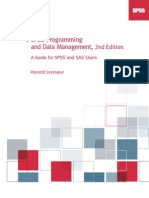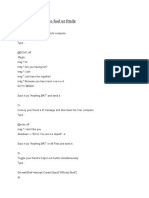Rintro
Uploaded by
Tom HenRintro
Uploaded by
Tom HenIntroduction to R
R is a high level language especially designed for statistical calculations. R is free. You can get it at: http://www.cran.r-project.org/ There are versions for Unix, Linux, Windows and Mac. There is a similar program called Splus. The commands in the two languages are virtually identical. Splus has more stu in it but R is free and it is faster. If you want to use Splus, you can purchase a copy from Insightful at http://www.splus.mathsoft.com/.
Getting Started
In Unix or Linux, you start R by typing: R. In windows, click on the R icon. You can now use R interactively. Just start typing commands. You can also use R in Batch mode. To do this, store your R commands in a le, say, le.r. In R type: source("file.r") which will execute the commands in le.r. In Unix (or Linux), you can also do the following: R BATCH file.r file.out & which will execute the commands and store them in le.out. NOTE: Use the command: q() to quit from R. Use help(xxxx) to get help on command xxxx. Better yet, type help.start() to open up a help window.
Basics
Here is a simple R session. The # symbol means comment. R ignores any command after #. I have added lots of comments below to explain what is going on. You do not need to type the comments. x = 5 x print(x) x <- 5 y = "Hello there" y y = sqrt(10) z = x + y ### ### ### ### assign x the value 5 print x another way to print x you can also use <- to make assignments
z q()
### Use this to quit
Scalars are treated by S-plus as vectors of length 1. That is why they print with a leading [1] indicating that we are at the rst element of a vector. Vectors can be created using the c() command. c() stands for concatenate. Square brackets are used to get subsets of a vector. The colon is used for sequences. Start up R again then do this: x = 1:5 print(x) x = seq(1,5,length=5) print(x) x = seq(0,10,length=101) print(x) x = 1:5 x[1] = 17 print(x) x[1] = 1 x[3:5] = 0 print(x) w = x[-3] print(w) y = c(1,5,2,4,7) y y[2] y[-3] y[c(1,4,5)] i = (1:3) z = c(9,10,11) y[i] = z print(y) ### the vector (1,2,3,4,5) ### same thing ### 0.0, 0.1, ..., 10.0
### everything except the third element of x
y = y^2 print(y) y = 1:10 y = log(y) y y = exp(y) y x = c(5,4,3,2,1,5,4,3,2,1) z = x + y z ### R carries out operations on 2
### vectors, element by element. If you add vectors of dierent lengths then R automatically repeats the smaller vector to make it bigger. This generates a warning if the length of the smaller vector is not the same length as the longer vector. x = 1 y = 1:10 x + y x = 1:3 y = 1:4 x + y
x = 1:10 y = c(5,4,3,2,1,5,4,3,2,1) x == 2 ### z = (x == 2) print(z) z = (x<5); print(z) ### ### x[x<5] = y[x<5] ### print(x) sort(y) rank(y) order(y) o = order(y) y[o]
This is a logical vector.
You can put two commands on a line if you use a semi-colon. Do you see what this is doing?
Two expressions can be written on the same line if separated by a semicolon. One expression can be written over several lines as long as a valid expression does not end a line.
Matrices and Lists
To create a matrix, use the matrix() function as follows: junk = c(1, 2, 3, 4, 5, 0.5, 2, 6, 0, 1, 1, 0) m = matrix(junk,ncol=3) print(m) m = matrix(junk,ncol=3,byrow=T) print(m) ### see the difference? 3
dim(m) y = m[,1] ### y x = m[2,] ### x z = m[1,2] print(z) zz = t(z) ### zz new = matrix( 1:9, 3 print(new) hello = z + new print(hello) m[1,3] subm = m[2:3, 2:4] m[1,] m[2,3] = 7 m[,c(2,3)] m[-2,] x1 = 1:3 x2 = c(7,6,6) x3 = c(12,19,21) A = cbind(x1,x2,x3)
y is column 1 of m x is row 2 of m
take the transpose , 3)
### Bind vectors x1, x2, and x3 into a matrix. ### Treats each as a column. ### Bind vectors x1, x2, and x3 into a matrix. ### Treats each as a row.
A = rbind(x1,x2,x3)
x = 1:20 A = matrix(x,4,5)
### Change vector x ### into a 4 by 5 matrix. get the dimensions of a matrix number of rows number of columns apply the sum function to the rows of A apply the sum function to the columns of A
dim(A) nrow(A) ncol(A) apply(A,1,sum) apply(A,2,sum)
### ### ### ### ###
B = matrix(rnorm(30),5,6) A %*% B ### multiply matrices t(A) ### transpose of A 4
x = 1:3 A = outer(x,x,FUN="*") ### outer product print(A) sum(diag(A)) ### trace of A A = diag(1:3) print(A) solve(A) ### inverse of A det(A) ### determinant of A Lists are used to combine data of various types. who = list(name="Joe", age=45, married=T) print(who) print(who$name) print(who[[1]]) print(who$age) print(who[[2]]) print(who$married) print(who[[3]]) names(who) who$name = c("Joe","Steve","Mary") who$age = c(45,23) who$married = c(T,F,T) who
For Loops etc.
A for loop is done as follows. for(i in 1:10){ print(i+1) } x = 101:200 y = 1:100 z = rep(0,100) help(rep) for(i in 1:100){ z[i] = x[i] + y[i] } w = x + y 5
### rep means repeat
print(w-z) ### As this example shows, we can often avoid using loops since ### R works directly with vectors. ### Loops can be slow so avoid them if possible. for(i in 1:10){ for(j in 1:5){ print(i+j) } } ### if statements for(i in 1:10){ if( i == 4)print(i) } for(i in 1:10){ if( i != 4)print(i) } for(i in 1:10){ if( i < 4)print(i) } for(i in 1:10){ if( i <= 4)print(i) } for(i in 1:10){ if( i >= 4)print(i) } You can also use while loops. i = 1 while(i < 10){ print(i) i = i + 1 }
### != means
not equal to
Functions
You can create your own functions in R. Here is an example. my.fun = function(x,y){ 6
##### This function takes x and y as input. ##### It returns the mean of x minus the mean of y a = mean(x)-mean(y) return(a) } x = runif(50,0,1) y = runif(50,0,3) output = my.fun(x,y) print(output) I like to call give functions names like xxxx.fun but this is not necessary. You can call them anything you like. You can return more than one thing in a function. If you put more than one thing in the return statement, the function returns a list. In the retrun statement, you can attach names to the items in the list. my.fun = function(x,y){ mx = mean(x) my = mean(y) d = mx-my return(meanx=mx,meany=my,difference=d) } x = runif(50,0,1) y = runif(50,0,3) output = my.fun(x,y) print(output) names(output) output$difference output[[3]] ### The following function will compute the square root of A: sqrt.fun = function(A){ e = eigen(A,symmetric=TRUE) sqrt.A = e$vectors %*% diag(sqrt(e$values)) %*% t(e$vectors) return(sqrt.A) }
A = diag(1:3) B = sqrt.fun(A) print(B) B %*% B 7
Statistics
### generate 100 numbers randomly between 0 and 1 ### 10 random Normals, mean 0, standard deviation 1
x = runif(100,0,1) y = rnorm(10,0,1) mean(y) median(y) range(y) max(y) min(y) sqrt(var(y)) summary(y) y = rpois(500,4) pnorm(2,0,1) pnorm(2,1,4) qnorm(.3,0,1) pchisq(3,6)
### ### ### ### ### ###
500 random Poisson(4) P(Z < 2) where Z ~ N(0,1) P(Z < 2) where Z ~ N(1,4^2) find x such that P(Z < x)=.3 where Z ~ N(0,1) P(X < 3) where X ~ chi-squared with 6 degrees of freedom
Plots
There are many options related to plotting. You control them with the par command, which stands for plotting pararameters. Type help(par). x = 1:10 y = 1 + x + rnorm(10,0,1) plot(x,y) plot(x,y,type="h") plot(x,y,type="l") plot(x,y,type="l",lwd=3) plot(x,y,type="l",lwd=3,col=6) plot(x,y,type="l",lwd=3,col=6,xlab="x",ylab="y") plot(1:20,1:20,pch=1:20) plot(1:20,1:20,pch=20)
par(mfrow=c(3,2)) ### put 6 plots per page, in a 3 by 2 configuration for(i in 1:6){ plot(x,y+i,type="l",lwd=3,col=6,xlab="x",ylab="y") }
### put the plots into a postscript file ### you have to do this if you use BATCH plot(x,y,type="l",lwd=3,col=6,xlab="x",ylab="y") dev.off() ### This turns the printing device off. ### This will close the postscript file so you ### can print it. ### Now you can print the file our view it with ### a previewer such as ghostview. par(mfrow=c(1,1)) ### return to 1 plot per page y = rpois(500,4) ### 500 random Poisson(4) hist(y) ### histogram hist(y,nclass=50) x = seq(-3,3,length=1000) f = dnorm(x,0,1) ### normal density plot(x,f,type="l",lwd=3,col=4) x = rnorm(1000) boxplot(x)
postscript("plot.ps")
Data Frames and Reading Data From Files
To read in commands or functions from a le rather than typing them in, use source(). Put some R commands into a le called hello. Try source("hello"). If you have data in a le, you can read it into R using the read.table command. Suppose le.txt looks like this: 2 3 3 2 1 4 17.2 8 12 3.4 19 52 101.2 1 3 Read the data as follows. a = read.table("file.txt") This places the data into a data frame. A data frame is like a matrix but is more general. Each column can be a dierent type of data (character, numeric etc.) Read the help le on data.frame and read.table for more information. You can also read data into a vector using the scan command: a = scan("file.txt") ### a is a vector a = matrix(a,ncol=3,byrow=T) print(a) 9
Regression
Here is how to do linear regression in R. First, you should read the help les on the commands lm (linear models) and step (stepwise regression): help(lm) help(step) Suppose you have three vectors y, x1 and x2 and you want to t the model:
Y = 0 + 1 x1 + 2 x2 +
x1 = seq(1,10,length=25) x2 = runif(25,3,7) y = 4 + 2*x1 + 7*x2 + rnorm(25,0,1) mydata = data.frame(y=y,x1=x1,x2=x2) out = lm(y ~ x1 + x2, data = mydata) names(out) extractAIC(out) s = summary(out) print(s) names(s) par(mfrow=c(2,2)) plot(out,ask=F) Another way to do linear regression is as follows: X = cbind(x1,x2) temp = lsfit(X,y) ls.print(temp) names(temp) To do stepwise regression: out = lm(y ~ x1 + x2,data = mydata) forward = step(out,direction="forward") backward = step(out,direction="backward") summary(forward) summary(backward) Here are some more regression examples. 10
### Cat example ### heartweight versus brainweight. library(MASS) ### This is the library from Modern Applied ### Statistics in S (Venables and Ripley) attach(cats) names(cats) summary(cats) postscript("cat.ps",horizontal=F) par(mfrow=c(2,2)) boxplot(cats[,2:3]) plot(Bwt,Hwt) out = lm(Hwt ~ Bwt,data = cats) summary(out) abline(out,lwd=3) names(out) r = out$residuals plot(Bwt,r,pch=19) lines(Bwt,rep(0,length(Bwt)),lty=3,col=2,lwd=3) qqnorm(r) dev.off() Now have a look at the le cats.ps. ### Rats example postscript("rats.ps",horizontal=F) par(mfrow=c(2,2)) data = c(176,6.5,.88,.42, 176,9.5,.88,.25, 190,9.0,1.00,.56, 176,8.9,.88,.23, 200,7.2,1.00,.23, 167,8.9,.83,.32, 188,8.0,.94,.37, 195,10.0,.98,.41, 176,8.0,.88,.33, 165,7.9,.84,.38, 158,6.9,.80,.27, 148,7.3,.74,.36, 149,5.2,.75,.21, 163,8.4,.81,.28, 170,7.2,.85,.34, 186,6.8,.94,.28, 11
146,7.3,.73,.30, 181,9.0,.90,.37, 149,6.4,.75,.46) data bwt lwt dose y n = = = = = = matrix(data,ncol=4,byrow=T) data[,1] data[,2] data[,3] data[,4] length(y)
out = lm(y ~ bwt + lwt + dose) summary(out) plot(out) infl = lm.influence(out) ### influence statistics hii = infl$hat delta.beta = round(infl$coef,3) st.res = infl$wt.res ### residuals for(i in 1:3){ plot(1:n,infl$coef[,i],pch=19,type="h") lines(1:n,rep(0,n),lty=3,col=2) } plot(1:n,st.res,type="h") lines(1:n,rep(0,n),lty=3,col=2) print(data[3,]) par(mfrow=c(1,1))
### remove third case y = y[-3] bwt = bwt[-3] lwt = lwt[-3] dose = dose[-3] out = lm(y ~ bwt + lwt + dose) summary(out) dev.off()
12
10
C functions in R
In Unix and Linux, you can include a C function (or Fortran function) into R as follows (the procedure in Windows is a bit dierent):
STEP (1): Write a C program. Here is an example: #include "stdio.h" #include "math.h" #include "stdlib.h" #define PI 3.14159 #define NMAX 100 double add(double *x, double *y, long *nn, double *out) { long n = *nn; int i; for(i=0;i<n;i++) out[i] = x[i] + y[i]; } Note 1: All arguments must be pointers. Note 2: Any variable that is integer in R must be long in C.
STEP (2): compile it. Assuming the le is called add.c, the compilation is done as follows: R CMD COMPILE add.c R CMD SHLIB add.o
STEP (3): Go into R and type: dyn.load("add.so") is.loaded("add")
STEP (4): Write an R function as follows: 13
add.fun = function(x,y){ n = length(x) out = as.double(rep(0,n)) z = .C("add",as.double(x),as.double(y),as.integer(n), out=as.double(out)) z } Note: It is best to use as.double and as.integer to make sure that the variables have the correct attributes. Note: To return something, you must set aside a variable. For example, the variable out is for that purpose. Make sure out is the right length. Now you can use this function just like any other R function. It is also possible to call R functions from C.
14
You might also like
- Troubleshooting-Stuck Pickrelease and ShippingTrans0% (1)Troubleshooting-Stuck Pickrelease and ShippingTrans30 pages
- Session Set Working Directory Choose DirectlryNo ratings yetSession Set Working Directory Choose Directlry17 pages
- A Short List of The Most Useful R CommandsNo ratings yetA Short List of The Most Useful R Commands8 pages
- A Short List of The Most Useful R CommandsNo ratings yetA Short List of The Most Useful R Commands11 pages
- Introduction To R: Nihan Acar-Denizli, Pau FonsecaNo ratings yetIntroduction To R: Nihan Acar-Denizli, Pau Fonseca50 pages
- FALL WIN SEM (2023-24) CSE0106 ETH AP2023243000534 Reference Material I 04-Nov-2023 Module4No ratings yetFALL WIN SEM (2023-24) CSE0106 ETH AP2023243000534 Reference Material I 04-Nov-2023 Module4102 pages
- Introduction To R Installation: Data Types Value ExamplesNo ratings yetIntroduction To R Installation: Data Types Value Examples9 pages
- Quick Introduction To Matlab: Basic Data AnalysisNo ratings yetQuick Introduction To Matlab: Basic Data Analysis10 pages
- R Is A Command Line Based Language All Commands Are Entered Directly Into The Console. RNo ratings yetR Is A Command Line Based Language All Commands Are Entered Directly Into The Console. R8 pages
- MATLAB MATLAB Lab Manual Numerical Methods and Matlab80% (5)MATLAB MATLAB Lab Manual Numerical Methods and Matlab14 pages
- Statistics With R Programming For Bigdata (Autosaved)No ratings yetStatistics With R Programming For Bigdata (Autosaved)41 pages
- Graphs with MATLAB (Taken from "MATLAB for Beginners: A Gentle Approach")From EverandGraphs with MATLAB (Taken from "MATLAB for Beginners: A Gentle Approach")4/5 (2)
- Normal Distribution Characterizations With ApplicationsNo ratings yetNormal Distribution Characterizations With Applications132 pages
- SPSS Programming and Data Management, 2nd Edition100% (2)SPSS Programming and Data Management, 2nd Edition390 pages
- Ecostruxure™ Power Monitoring Expert 9.0: Etl For 3Rd Party Billing - Administration GuideNo ratings yetEcostruxure™ Power Monitoring Expert 9.0: Etl For 3Rd Party Billing - Administration Guide22 pages
- MilestoneXProtectRapidReview InstallationGuide en-USNo ratings yetMilestoneXProtectRapidReview InstallationGuide en-US68 pages
- An A-Z Index of The Command Line: Windows CMDNo ratings yetAn A-Z Index of The Command Line: Windows CMD6 pages
- Installation Guide: Multiuser/Multitasking Operating SystemNo ratings yetInstallation Guide: Multiuser/Multitasking Operating System45 pages
- IBM Datacap Application Development Guide 9No ratings yetIBM Datacap Application Development Guide 91,076 pages
- T3TAFJ3 TAFJ Tools Compiler and Runner R16No ratings yetT3TAFJ3 TAFJ Tools Compiler and Runner R1635 pages
- External Tables: - Not Just Loading A CSV File Kim Berg Hansen Senior ConsultantNo ratings yetExternal Tables: - Not Just Loading A CSV File Kim Berg Hansen Senior Consultant57 pages
- Map Network Drives On Domain Login For All UsersNo ratings yetMap Network Drives On Domain Login For All Users2 pages
- NetVault Backup Teradata Plugin Users Guide EnglishNo ratings yetNetVault Backup Teradata Plugin Users Guide English110 pages
- Troubleshooting-Stuck Pickrelease and ShippingTransTroubleshooting-Stuck Pickrelease and ShippingTrans
- Introduction To R: Nihan Acar-Denizli, Pau FonsecaIntroduction To R: Nihan Acar-Denizli, Pau Fonseca
- FALL WIN SEM (2023-24) CSE0106 ETH AP2023243000534 Reference Material I 04-Nov-2023 Module4FALL WIN SEM (2023-24) CSE0106 ETH AP2023243000534 Reference Material I 04-Nov-2023 Module4
- Introduction To R Installation: Data Types Value ExamplesIntroduction To R Installation: Data Types Value Examples
- R Is A Command Line Based Language All Commands Are Entered Directly Into The Console. RR Is A Command Line Based Language All Commands Are Entered Directly Into The Console. R
- MATLAB MATLAB Lab Manual Numerical Methods and MatlabMATLAB MATLAB Lab Manual Numerical Methods and Matlab
- Statistics With R Programming For Bigdata (Autosaved)Statistics With R Programming For Bigdata (Autosaved)
- Graphs with MATLAB (Taken from "MATLAB for Beginners: A Gentle Approach")From EverandGraphs with MATLAB (Taken from "MATLAB for Beginners: A Gentle Approach")
- Normal Distribution Characterizations With ApplicationsNormal Distribution Characterizations With Applications
- Ecostruxure™ Power Monitoring Expert 9.0: Etl For 3Rd Party Billing - Administration GuideEcostruxure™ Power Monitoring Expert 9.0: Etl For 3Rd Party Billing - Administration Guide
- MilestoneXProtectRapidReview InstallationGuide en-USMilestoneXProtectRapidReview InstallationGuide en-US
- Installation Guide: Multiuser/Multitasking Operating SystemInstallation Guide: Multiuser/Multitasking Operating System
- External Tables: - Not Just Loading A CSV File Kim Berg Hansen Senior ConsultantExternal Tables: - Not Just Loading A CSV File Kim Berg Hansen Senior Consultant
- NetVault Backup Teradata Plugin Users Guide EnglishNetVault Backup Teradata Plugin Users Guide English





























































































